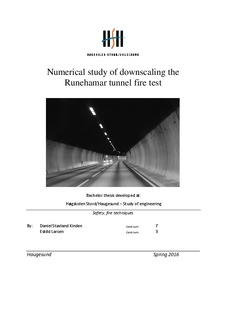| dc.description.abstract | An increase in tunnels in Norway, have brought forth a higher demand for safety measures, amongst others, fire safety. Experimental fire safety data from tunnels that contributes to solving engineering problems with low cost and availability is therefore important. Main objective in this assignment is to determine, the possibility of using downscaled tunnels to conduct experimental research in fire safety and conducting a grid-sensitivity analysis, using numerical calculations.
Runehamar fire test tunnel is the comparable object in this study, mainly because of the experimental data available. The data contained measurements of temperature, velocity, heat release rate (HRR) and visibility. The simulations were performed in full-scale, 65%, 15% and 5%-scale.
Previous research done on scaling of a tunnel in simulation, suggest Froude scaling. A technique where HRR, velocity, time, energy and mass is scaled to a dimensionless unit by preserving the Froude number.
Fire Dynamics Simulation (FDS) is an open source software, often used in fire-research. FDS is known all over the world in engineering communities and is a well-validated tool for fire simulation [1]. The tunnel was simplified by making the cross-section rectangular (instead of oval), and shortened until 100 meters upstream from the fire. A fan, with an airflow of 3 m/s, replaced the opening at the 100 meters mark. The domain surrounding the west portal was extended 25 meters with open boundaries. After several tests with different HRR, the chosen fire was a 2,27 m in diameter diesel fire corresponding to 6 MW.
The grid sensitivity criteria was conducted by two different approaches. The first is a method of checking if convergence occur, by refining the grid cell and comparing the results, similarities give convergence. The second is a measure of turbulence resolution (MTR).
Basically by using smokeview, a software that enables the user access to view the simulation, the resolved and unresolved turbulence can be observed. First method of convergence testing gave poor results, unable to reach full convergence. MTR however, gave promising results, resolving over the limit criteria for LES.
Comparison of temperature results in full-scale simulation and experimental data from the Runehamar tunnel test, show good results. However, there are some overestimations in the full-scale simulation. Furthermore, the scaled simulations follow a similar pattern of underestimating the results for every downscaling. Occurring when the tunnel is scaled lower than 65 %, and may be a result of radiation scaling. This study suggests that scaling down more than 65 % leads to underestimated results. | nb_NO |
